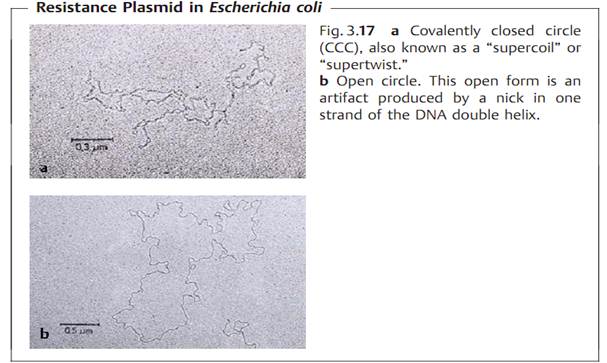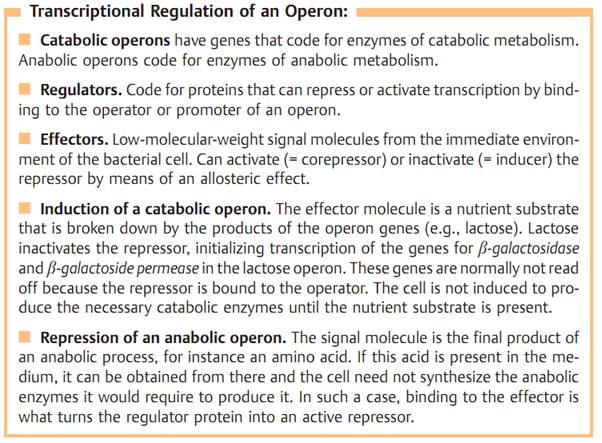


 النبات
النبات
 الحيوان
الحيوان
 الأحياء المجهرية
الأحياء المجهرية
 علم الأمراض
علم الأمراض
 التقانة الإحيائية
التقانة الإحيائية
 التقنية الحيوية المكروبية
التقنية الحيوية المكروبية
 التقنية الحياتية النانوية
التقنية الحياتية النانوية
 علم الأجنة
علم الأجنة
 الأحياء الجزيئي
الأحياء الجزيئي
 علم وظائف الأعضاء
علم وظائف الأعضاء
 الغدد
الغدد
 المضادات الحيوية
المضادات الحيوية|
Read More
Date: 21-3-2016
Date: 3-3-2016
Date: 14-3-2016
|
The Molecular Basis of Bacterial Genetics
Introduction
Bacteria possess two genetic structures: the chromosome and the plasmid. Both of these structures consist of a single circular DNA double helix twisted counterclockwise about its helical axis. Replication of this DNA molecule always starts at a certain point (the origin of replication) and is “semiconservative,” that is, one strand in each of the two resulting double strands is conserved. Most bacterial genes code for proteins (polypeptides). Noncoding interposed sequences (introns), like those seen in eukaryotes, are the exception. Certain bacterial genes have a mosaic structure. The phases of transcription are promoter recognition, elongation, and termination. Many bacterial mRNAs are polycistronic, meaning they contain the genetic information for several polypeptides. Translation takes place on the 70S ribosomes. Special mRNA codons mark the start and stop of polypeptide synthesis. Many genes that code for functionally related polypeptides are grouped together in chromosome or plasmid segments known as operons. The most important regulatory mechanism is the positive or negative control of transcription initiation. This control function may be exercised by individual localized genes, the genes of an operon or genes in a regulon.
The Structure of Bacterial DNA
A bacterium's genetic information is stored in its chromosome and plasmids. Each of these structures is made of a single DNA double helix twisted to the right, then additionally twisted to the left about its helical axis ( Fig. 3.17). Plasmids consisting of linear DNA also occur, although this is rare. This DNA topology solves spatial problems and enables such functions as replication, transcription, and recombination. Some genes are composed of a mosaic of minicassettes interconnected by conserved DNA sequences between the cassettes .
Chromosome. The chromosome corresponds to the nucleoid (p. 148ff.). The E. coli chromosome is composed of 4.63 x 106 base pairs (bp). It codes for 4288 proteins. The gene sequence is colinear with the expressed genetic products. The noncoding interposed sequences (introns) normally seen in eukaryotic genes are very rare. The chromosomes of E. coli and numerous other pathogenic bacteria have now been completely sequenced.
Plasmids. The plasmids are autonomous DNA molecules of varying size (3 x 103 to 4.5 x 105 bp) localized in the cytoplasm. Large plasmids are usually present in one to two copies per cell, whereas small ones may be present in 10, 40, or 100 copies. Plasmids are not essential to a cell's survival.

Many of them carry genes that code for certain phenotypic characteristics of the host cell. The following plasmid types are medically relevant:
- Virulence plasmids. Carry determinants of bacterial virulence, e.g., enterotoxin genes or hemolysin genes.
- Resistance plasmids. Carry genetic information bearing on resistance to anti-infective agents. R plasmids may carry several R genes at once . Plasmids have also been described that carry both virulence and resistance genes.
DNA Replication
The identical duplication process of DNA is termed semiconservative because the double strand of DNA is opened up during replication, whereupon each strand serves as the matrix for synthesis of a complementary strand. Thus each of the two new double strands “conserves” one old strand. The doubling of each DNA molecule (replicon) begins at a given starting point, the so-called origin of replication. This process continues throughout the entire fission cycle.
Transcription and Translation
- Transcription. Copying of the sense strand of the DNA into mRNA. The continuous genetic nucleotide sequence is transcribed “colinearly” into mRNA. This principle of colinearity applies with very few exceptions. The transcription process can be broken down into the three phases promoter recognition, elongation, and termination. The promoter region is the site where the RNA polymerase begins reading the DNA sequence. A sigma factor is required for binding to the promoter. Sigma factors are proteins that associate temporarily with the RNA polymerase (core enzyme) to form a holoenzyme, then dissociate themselves once the transcription process has begun, making them available to associate once again. Specific sigma factors recognize the standard promoters of most genes. Additional sigma factors, the expression of which depends on the physiological status of the cell, facilitate the transcription of special determinants. Genes that code for functionally related proteins, for example proteins that act together to catalyze a certain metabolic step, are often arranged sequentially at specific locations on the chromosome or plasmid. Such DNA sequences are known as operons (Fig. 3.18). The mRNA synthesized by the transcription of an operon is polycistronic, i.e., it contains the information sequences of several genes. The information sequences are separated by intercistronic regions. Each cistron has its own start and stop codon in the mRNA.

Translation. Transformation of the nucleotide sequence carried by the mRNA into the polypeptide amino acid sequence at the 70S ribosomes. In principle, bacterial and eukaryotic translation is the same. The enzymes and other factors involved do, however, differ structurally and can therefore be selectively blocked by antibiotics .
Regulation of Gene Expression
Bacteria demonstrate a truly impressive capacity for adapting to their environment. A number of regulatory bacterial mechanisms are known, for example posttranslational regulation, translational regulation, transcription termination, and quorum sensing. The details of all these mechanisms would exceed the scope of this book. The most important is regulation of the initiation of transcription by means of activation or repression, a process not observed in this form in eukaryotes: a single gene, or several genes in an operon at one DNA location, may be affected (see Fig. 3.18). The mechanism that has been investigated most thoroughly is transcriptional regulation of catabolic and anabolic operons by a repressor or activator.

A single regulator protein can also activate or repress several genes not integrated in an operon, i.e., at various locations on the DNA. Such functional gene groups are called regulons. Alternative sigma factors may be involved in the transcriptional activation of special genes with special promoters. Physiological cell status determines whether or not these alternative factors are produced.



|
|
|
|
تفوقت في الاختبار على الجميع.. فاكهة "خارقة" في عالم التغذية
|
|
|
|
|
|
|
أمين عام أوبك: النفط الخام والغاز الطبيعي "هبة من الله"
|
|
|
|
|
|
|
قسم شؤون المعارف ينظم دورة عن آليات عمل الفهارس الفنية للموسوعات والكتب لملاكاته
|
|
|